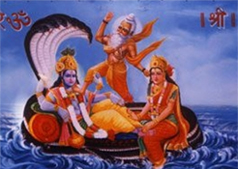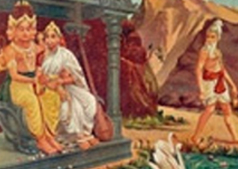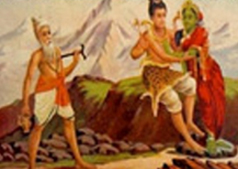There are two groups; Vaishnava & Shaiva, who interprets the origin of the word Pamashali as under:



There are two groups; Vaishnava & Shaiva, who interprets the origin of the word Pamashali as under:
The Vaishnava group says that Padmashali is a conflation of two words, Padma and Shali. The word "Padma" is sahasradala padma, meaning the highest order of human intelligence. In body chakras "Padma" refers to sahasrara. The word "Shali" in Sanskrit is 'be holder'. Thus "Padmashali" literally means holder of sahasrara. In physical term it means intelligence.
We strongly believe that Padmavathi of Mangapura / tiruchanur of Tirupati, the Shasanam of the temple, declares that Padmavathi, is daughter of Padmashali. Hence, the name Padmashali. There exists writing in Tirupati to evidence the statement of Padmavathi as daughter of Padmashali's. Another aspect of Padmashali, Padma also refers to Lotus. The Lotus also refers to the intelligence or awakening of Sahasrara. The word Padma also means lotus thread.
Markandeya Mahamuni was advised by Siva to perform a Hawan to sacrifice. Shri Bhavana Rishi arose from Home Kund, holding a lotus flower Padma in his hand. He is later known as Bhavanarayana.
Bhavna Rishi had two wives, Prasannavati and Bhadravathi, daughters of Surya (The Sun) and chayadevi. who had a hundred and one sons.
Markandeswara conducted Homa for Loka Kalyana at the instance of Srimannarayana (Vishnu).
Srimannarayana given a lotus stem from his nabhimandal to Bhavana Maharshi to weave cloth. Bhavana took up the task and weaved a cloth and gave to Srimannarayana. Narayana pleased with the lotus cloth blessed him that his progenitors of the one hundred and one Gotras be known as PADMASHALIs.
Markandeya gave fifth veda called Padma Veda; fifth petals of lotus flower. Other four petals of lotus are 4 vedas. So family of this caste belong to Padma Sakha and Markandeya Sutra analogous to the Sakhas, Sutras and Gotras of the Brahmans.
The Padmashalis relate their origin to Vrushis, sages as gothras. Hence, Padmashalis caste of Brahminical not by birth but by deeds. Each family has separate gothras. The family name and gothras will be referred at the time of marriage and sagothras and like family name are barred in going in for marriage.
All Padmasalis claim Rishi gothras of 101 rishi "santhathi" who were taken on adoption by the sage Bhavana Rishi, who himself was taken on adoption by Rishi Markandeya.
All Padmasalis originated from Satavahana empire and their mother tongue remains Telugu, except for a few migrants who had taken longer and numerous stages of migration such as the Shettigars of Dakshina Kannada. Most Padmashalis in Tamil Nadu, Karnataka, Maharashtra, Chatttisgadh, Madhya Pradesh and Orissa speak Telugu as mother tongue.
The Padmashalis are the third largest community in Andhra Pradesh. Their main occupation is weaving. To grow further in their business, they intent moving to urban and semi-urban centers. This would enable them to get raw materials like cotton and animate yarn (silk) and also sell their hand woven cloths on Moggalu to various categories of society peoples.
The invasion of Britishers in India and subsequently introduction of Railways in 1853 helped penetrate the self sufficient rural economy. From imperial British Government, we were forced to buy their machine manufactured goods, especially finished cotton goods from the factories of Brimingham & Lancashire, the domestic textile industry suffered a huge losses.
The Padmashali community felt the impact. Today, many urban Padmashalis have abandoned their ancestral profession and have diversified into other activities. One can see an increasing number of Padmashalis become engineers, doctors, politicians, bureaucrats, businessmen, advocates, professionals etc.
Perhaps because they largely stay indoors, or because of characteristic genes, community members have developed reddish skin and are hence known as erra kulamu (red caste) among the OBCs. The Padmashali caste is highly Sanskritised, with all the men wearing the sacred thread (Yajnopavitam/Gayatri dharan). In terms of social consciousness, it is more Brahminic than any other OBC caste in Andhra Pradesh and some of them in Maharashtra also(In Maharashtra,state government declare Padmashali as a SBC caste).
The weavers of different groups have different names. The Padmashali sources its origin to Brugu Maharshi, followed down to Markandeya, Bhakta Markandeya, the chiranjeevi who wins the life from Yama Dharma Raju. The technique of weaving came from Ayoni Putra, Sri Bhavana maharshi. The weavers in Andhra Pradesh has following names (as per the OBC list of central government - List no 155), they are all not Padmashalis. But the weavers, depending upon on the nature of basic material used in the earlier times, the name of caste originated.
Padmasali: caste people live in Andhra Pradesh, Karnataka, Mumbai, Solapur, Ahmedabad, Saliyar/Padmasaliyar, kumbakonam=Tamil Nadu, all speaks Telugu with local language.
Devanga: Karnataka (Kannada)
Pattarya: Kerala (Malayalam)
Shettigar: Karnataka (Tulu), they are sub sect of Padmashali
Saliya/Padmashali/Devanga, devanga and Padmashali are not same and different culture, practice and origin. and are not same except weaving. However, Kannada and Telugu Salis differ from Malayalee Salis in many cultural aspects. The former are patriarchical follow many Brahmanical customs.
Source : http://www.markandeya.in/markandeya-aboutmarkandeya-padmashali.php